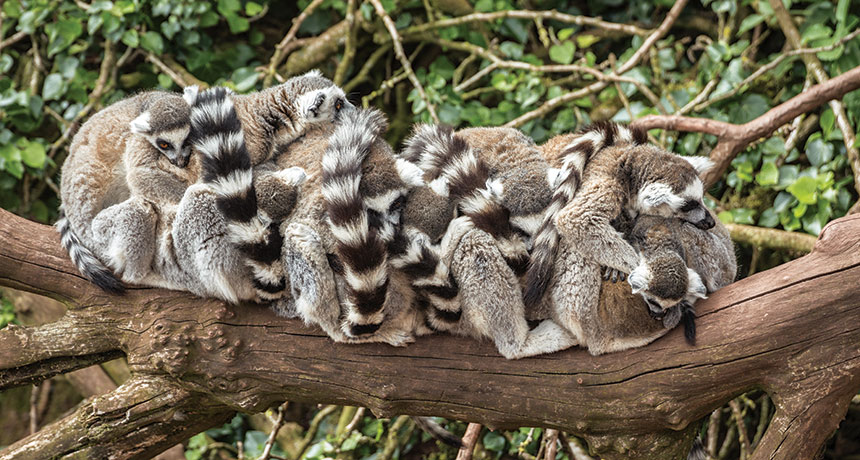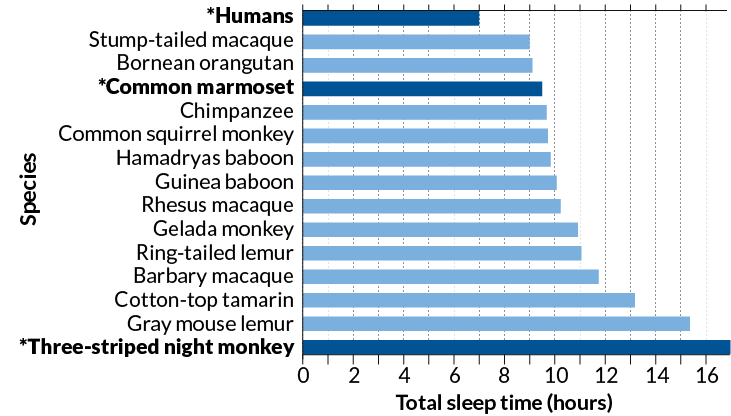Compared to other primates, humans get little sleep
Time for learning comes at the expense of shut-eye, researchers propose

Humans get far less sleep than expected for a primate, new data show. Most of the studied primates, including ring-tailed lemurs (like these), sleep about as much on average as researchers estimated they should.
ARROWSG/ISTOCKPHOTO
By Bruce Bower
If it seems like you’re not getting enough sleep, you’re not alone. People have evolved to sleep much less than chimps, baboons or any other primate studied so far, a new study finds.
Charles Nunn and David Samson are evolutionary anthropologists. They study how humans have evolved to behave the way we do. Nunn works at Duke University in Durham, N.C. Samson works at the University of Toronto Mississauga in Canada. In their new study, the two compared sleep patterns in 30 different species of primates, including humans. Most species slept between nine and 15 hours daily. Humans averaged just seven hours of shut-eye.
Based on lifestyle and biological factors, however, people should get 9.55 hours, Nunn and Samson calculate. Most other primates in the study typically sleep as much as the scientists predicted they should. Nunn and Samson shared their findings online February 14 in the American Journal of Physical Anthropology.
Why we sleep less
The researchers argue that two long-standing features of human life may play into our short sleep times. The first stems from when humans’ ancestors descended from the trees to sleep on the ground. At that point, people probably had to spend more time awake to guard against predators. The second may reflect the intense pressure humans face to learn and teach new skills and to make social connections. That has left less time for sleep.
As sleep declined, rapid-eye movement — or REM — sleep took on an outsize role in humans, Nunn and Samson propose. REM sleep is when we dream. And it has been linked to learning and memory.
“It’s pretty surprising that non-REM sleep time is so low in humans,” Nunn says. “But something had to give as we slept less.”
Isabella Capellini is an evolutionary biologist at the University of Hull in England. She says the new study does show that people may sleep for a surprisingly short time for primates. However, she cautions, their sample of 30 species is too small to reach any firm conclusions. There may be 300 or more primate species.

If the findings hold up, though, Capellini suspects that a change in sleeping patterns also may have lessened humans’ sleep time. People get most sleep in just one bout per day. Some other primates sleep in several bouts that vary in how long they last.
Calculating primate sleep
Nunn and Samson considered various traits about the animals and their environments in calculating how long they would expect each species to sleep. For 20 of those species, enough data existed to estimate how long the REM and non-REM portions of their sleep would last.
Such estimates relied on previous measurements of primate sleep. Those studies largely involved captive animals that had worn electrodes that measured brain activity as they snoozed. The researchers then predicted sleep values for each primate. For this, they looked at earlier studies of links between sleep patterns and various aspects of the species’ biology, behavior and environments. For instance, nocturnal animals tend to sleep longer than do those awake during the day. And species that travel in small groups or that inhabit open habitats along with predators tend to sleep less.
Based on such traits, the researchers predicted humans should sleep an average of 9.55 hours each day. In fact, they sleep only around 7 hours daily. Some people slumber even less. The 36 percent shortfall between predicted and actual sleep is far greater than for any other species in this study.
People now spend an average of 1.56 hours of snooze time in REM, Nunn and Samson estimate. That’s about what they would predict. But that was accompanied by a hefty drop in non-REM sleep, they note. They calculated that people should actually spend an average of 8.42 hours daily in non-REM sleep. The actual figure: 5.41 hours.
One other primate, South America’s common marmoset (Callithrix jacchus), also sleeps less than predicted. These monkeys sleep an average of 9.5 hours. Their non-REM sleep was also shorter than expected. Only one species slept far more per day than predicted. South America’s nocturnal three-striped night monkey (Aotus trivirgatus) catches nearly 17 hours of shut-eye.
Why their sleep patterns don’t match expectations is unclear, Nunn says. However, he adds, neither monkey departs from its predicted sleep patterns as much as humans do.







